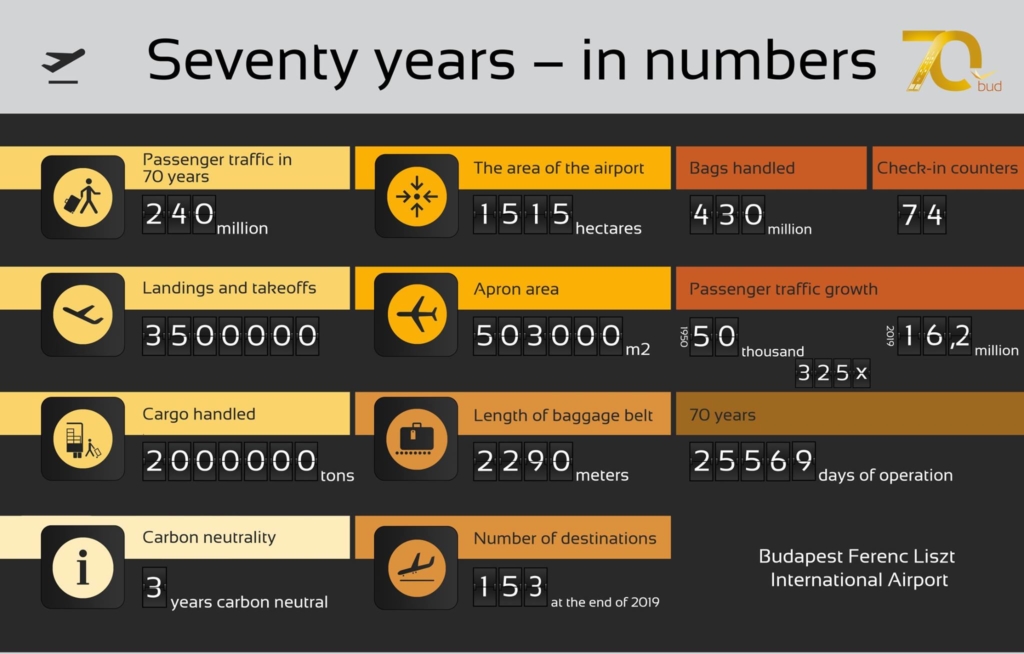Happy 70th Birthday Budapest Airport!

The international airport of Budapest, the aerial gateway to Hungary was inaugurated 70 years ago, on 7 May 1950. Over the past seven decades, hundreds of millions of passengers and millions of aircraft have used the runways and the terminal buildings of the airport.
Seven decades, more than 240 million passengers, approximately 3 and a half million landings and takeoffs, 2 million tons of goods – this is the history, in a nutshell, of the international airport of Budapest, which has been operational for seventy years. Since the inauguration ceremony held on 7 May 1950, the airport has been operating for 25 569 days. Before the coronavirus pandemic, airport staff handled 40-44 000 passengers and 336 flights on average per day. At the end of 2019, aircraft connected Budapest with 153 foreign destinations.
- Budapest Airport slowly restarts passenger services!
- Coronavirus – First post-lockdown flights take off from Budapest Airport
Budapest Airport lies between Budapest Districts XVII and XVIII and the city of Vecsés, on 1515 hectares, approximately 15 times the area of Margaret’s Island in Budapest. There are more than 200 buildings in this huge expanse, with numerous warehouses, office buildings, the airport’s own power plant, Police and firefighter unit, terminal and logistics buildings.
The airport handled nearly 50 000 passengers in 1950, the year of its opening. Traffic reached a new record in 2019, with 16.2 million passengers using Ferenc Liszt International Airport, which means that passenger traffic increased 325-fold in 70 years. The 21 000 square meters of terminal capacity that existed at the time of opening has grown to more than 103 000 square meters by 2020.
According to estimates, the airport handled approximately 430 million pieces of (hold and hand) baggage over the past 70 years. Currently, a 2290-meter long baggage belt consisting of 531 belt sections and screening devices provides for the movement of bags from the 74 check-in counters to the baggage sorting hall.

Ferenc Liszt International Airport has two runways; runway I, also 70 years old, is 3009 meters long and 45 meters wide, runway II, commissioned in 1983, is 3707 meters long and 45 meters wide. The taxiway network is 18 kilometers long, the terminal aprons, in front of Terminal 1, Terminal 2 and the Cargo City, are more than 503 000 square meters in total. Up to 75 aircraft fit on the terminal aprons concurrently and 38 aircraft can be handled on the apron of Terminal 2 at any time. By summer 2020, passengers can board via 57 boarding gates and 17 air jetties.
The airport ensures a seamless fuel supply for aircraft by storing kerosene enough for 5-7 days. The storage tanks located in its area can accommodate more than 6400 tons of kerosene in total. An interesting piece of data from the history of fuel supply at the airport is that the largest quantity ever filled into a single aircraft was 170 000 liters.
In terms of air cargo, Ferenc Liszt International Airport handled approximately 2 million tons of goods over seven decades. 3000 tons of cargo arrived in and departed from Budapest on average during the first decades of the airport’s history. By 2020, Budapest Airport’s air cargo handling capacity has reached 250 000 tons annually.
Over the past 5 years, cargo traffic at the airport increased by 60% to approximately 150 000 tons per year.
The world-class cargo base handed over last year also boasts numerous interesting facts and figures. The total area of the Cargo City’s buildings is 32 850 square meters. Its 32 000 square meter apron, approximately the size of 6 football pitches, is able to concurrently serve two Boeing 747-8F type aircraft, with a maximum takeoff weight of 440 tons each. This apron and the adjoining taxiway were constructed using 15 000 cubic meters of basalt concrete. The same quantity of water would be enough to fill six Olympic swimming pools. The apron is 65 centimeters thick and has a huge loadbearing capacity; it could safely support the weight of 80 African elephants.
Budapest Airport has been awarded ACI’s neutral airport carbon accreditation for the third year running, and thus remains a member of the elite club of airports which fully offset the carbon dioxide emissions generated in the course of their operation, in a sustainable manner. Budapest Airport is the only airport in the Central and Eastern European region to receive such accreditation.
Budapest Airport began to calculate its carbon footprint, i.e. the environmental burdens generated by airport operation, 10 years ago, in 2010. During this time, the carbon footprint was reduced by 39% in absolute terms and by 65% calculated per passenger. This is largely the result of the reduction of energy consumption, energy efficiency improvements and the increase in passenger traffic.
Source: www.bud.hu/en






Also a Happy VE Day today (8th May) the 75th anniversary when Europe was liberated from the Nazi regime by the allies. The day Germany unconditionally surrendered. It is being commemorated appropriately in various parts of the world. Let us remember the number of lives that were pointlessly lost.